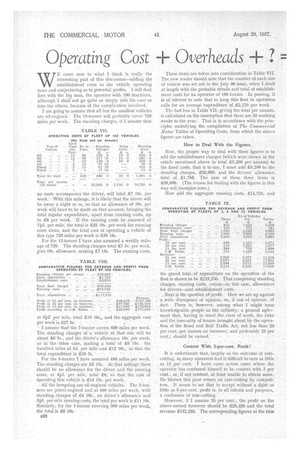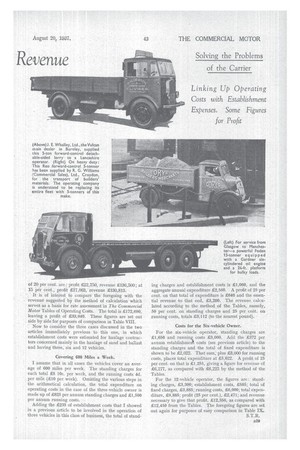Operating Cost + Overheads ?
Page 38

Page 39

If you've noticed an error in this article please click here to report it so we can fix it.
Linking Up Operating Costs with Establishment Expenses. Some Figures for Profit
WE come now to what I think is really the interesting part of this discussion-adding the establishment costs to the vehicle operating costs and conjecturing as to potential profits. I will deal first with the big man., the operator with 100 machines, although 1 shall not go quite so deeply into his case as into the others, because of the complication involved.
I am going to assume that all but the smallest vehicles are oil-engined. The 15-tonner will probably cover 720 miles per week. The standing charges, if I assume that
ILO mate accompanies the driver, will total £7 10s. per week.With this mileage, it is likely that the driver will be away a night or so, so that an allowance of 10s. per week will have to be made on that account, bringing the total regular expenditure, apart from running costs, up to 2.8 per week. If the running costs be assumed at 70. per mile, the total is £22 10s. per week for running costs alone, and the total cost of operating a vehicle of this type 720 miles per week is £30 10s.
For the 12-tonner I have also assumed a, weekly mileage of 720. The standing charges total £7 5s. per week, plus 10s. allowance, making 27 15s. The running costs,
at Gicr per mile, total £19 1.0s2, and the,aggregate cost per week is 227 5s.
I assume-that the 7-tonner covers 600 miles per week. The standing chargesof . a vehicle of that size will -be about 26 5s., and the driver's allowance 10s. per week, as in the other case, making a total of £6 15s. Six hundred miles at 5d. per -mile cost £12 10s., so that the totalexpenditure is 19 5s..
For the 5-tonner I have assumed 480 miles per week. The standing charges are £5 15s. At that mileagethere should be no allowance for the driver and the running costs, at 40. per mile, total 29, se that the cost of operating this vehicle is 214 15s. per week.
All the foregoing are oil-engined vehicles. The 3-lonners are petrol-engined and at 480 miles per week, with standing charges of £4 10s.-, no driver's allowance and 31(1. per mile running costs, the total per week is 211 10s. Similarly, for the 1-tonner covering 360 miles per week, the total is 26 10s.
These items are taken into consideration in Table VII. The new reader should note that the number of each size of vehicle was set out in the July 30 issue, when I dealt at length with the probable details and total of establishment costs for an operator of 100 lorries. In passing, it is of interest to note that to keep this fleet in operation calls for an average 'expenditure of 42,170 per week.
The last line in Table VII,giving the total per annum, is calculated on the assumption that there are 50 working weeks to the year. That is in accordance with the principles underlying the compilation of The Commercial Motor Tables of Operating Costs, from which the above figures are taken. .
How to Deal With the Figures.
Now, the proper way to deal with these figures is to add the establishment charges (which were shown in the article mentioned above to total £5,250 per annum) to the fixed costs, that is to say, I must add ,5,250 to the standing charges, £32,000, and.. .the drivers' allowance. total of 21,750. The sum of these three items is 239,000. (The reason for dealing with the figures in this
way will transpire later.) • Now add the aggregate running costs, 274,750, and the grand total of expenditure on the operation of the fleet is shown to be £113,750. That comprising standing charges, running costs, extras-in this case, allowances' for drivers-and establishment costs. • , Next is the question of profit Here we are up against a wide divergence Of opinion, or, if not of opinion, of -fact. There is, however, arnong what I might term knowledgeable people in the industry, a general agieemeat that, having in mind the -class of work, the risks and the insecurity of tenure brought about by the operation of -the Road and Rail Traffic Act, not less than 20 per cent...per annum-on turnover, and preferably 25 per cent.; should be earned.
Content With 5-per-cent. Profit!
It is unfortunate, that, largely as the outcome of ratecutting, so many operators find it difficult to earn as little as 15 per cent. I have come across cases where the operator has confessed himself to be content with 5 per cent„ or, if not content, at least unable to obtain more. He blatnes this poor return, on rate-cutting by competitors. It seems to' me that to accept without a fight as little as 5-per-cent: profit is, to all intents and purpoSes, a confession of rate-cutting.
However, if I assume 25 per cent., the profit on the. above-named turnover should be 428,438 and the total revenue £142,188. The corresponding figures at the iate
of 20 per cent. are : profit £22,750, revenue £136,500; at 15 per cent, profit £17,063, revenue £130,813.
It is of interest to compare the foregoing with the revenue suggested by the method of calculation which • serves as a basis for rate assessment in The Commercial Motor Tables of Operating Costs. The total is 2172,690, leaving a profit of 233,940. These figures are set out side by side for purposes of comparison in Table VIII. Now to consider the three cases discussed in the two articles immediately previous to this one, in which establishment costs were estimated for haulage contractors concerned mainly in the haulage of sand and ballast and having three, six and 12 vehicles.
Covering 600 Miles a Week.
I assume that in all cases the vehicles cover an average of 600 miles per week. The standing charges for each total E5 10s. per week, and the running costs 4d. per mile (£10 per week). Omitting the various steps in the arithmetical calculation, the total expenditure on operating costs in the case of the three-vehicle owner is made up of £825 per annum standing charges and £1,500 per annum running costs.
Adding the £235 of establishment costs that I showed in a previous article to be involved in the operation of three vehicles in this class of business, the total of stand ing charges and establishment costs is £1,060, and the aggregate annual. expenditure £2,560. A profit of 25 per cent. on that total of expenditure is £640 and the essential revenue to that end, £3,200. The revenue calculated according to the method of the Tables, namely, 50 per cent. on standing charges and 25 per cent. on running costs, totals £3,112 (to the nearest pound).
Costs for the Six-vehicle Owner.
For the six-vehicle operator, standing charges are £1,650 and running costs £3,000. Add the £372 per annum establishmen‘ costs (see previous article) to the standing charges and the total of fixed expenditure is shown to be £2,022. That sum, plus £3,000 for running costs, places total expenditure at £5,022. A profit of 25 per cent. on that is £1,255, giving a figure for revenue of £6,277, as compared with £6,225 by the method of the Tables.
For the 12-vehicle operator, the figures are : standing charges, £3,300; establishment costs, £585; total of fixed charges, £3,885; running costs, £6,000; total expenditure, £9,885; profit (25 per cent.), £2,471; and revenue necessary to give that profit, £12,356, as compared with £12,450 from the Tables. The foregoing figures are set out again for purposes of easy comparison in Table IX. S.T.R. a29




















































































